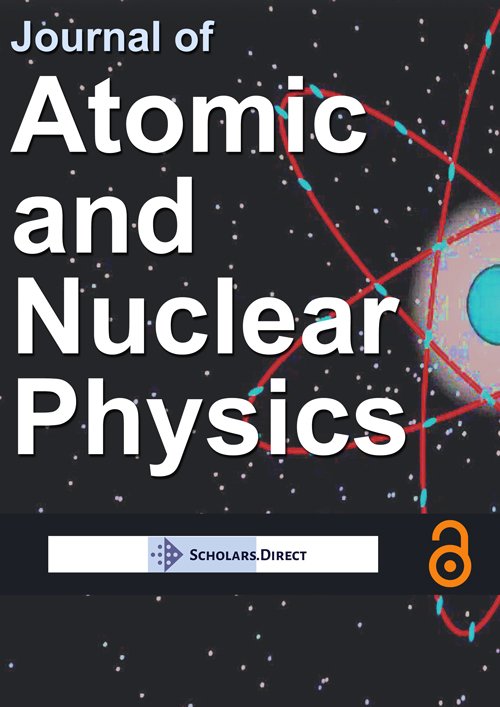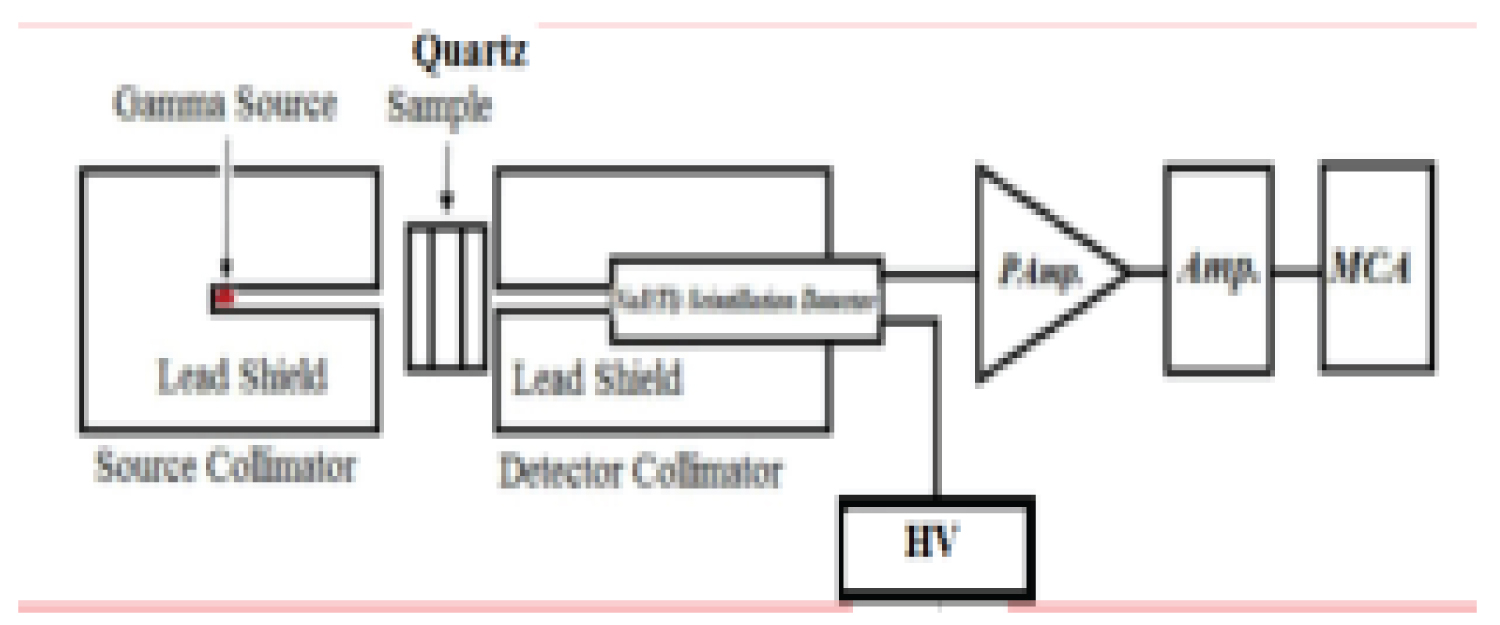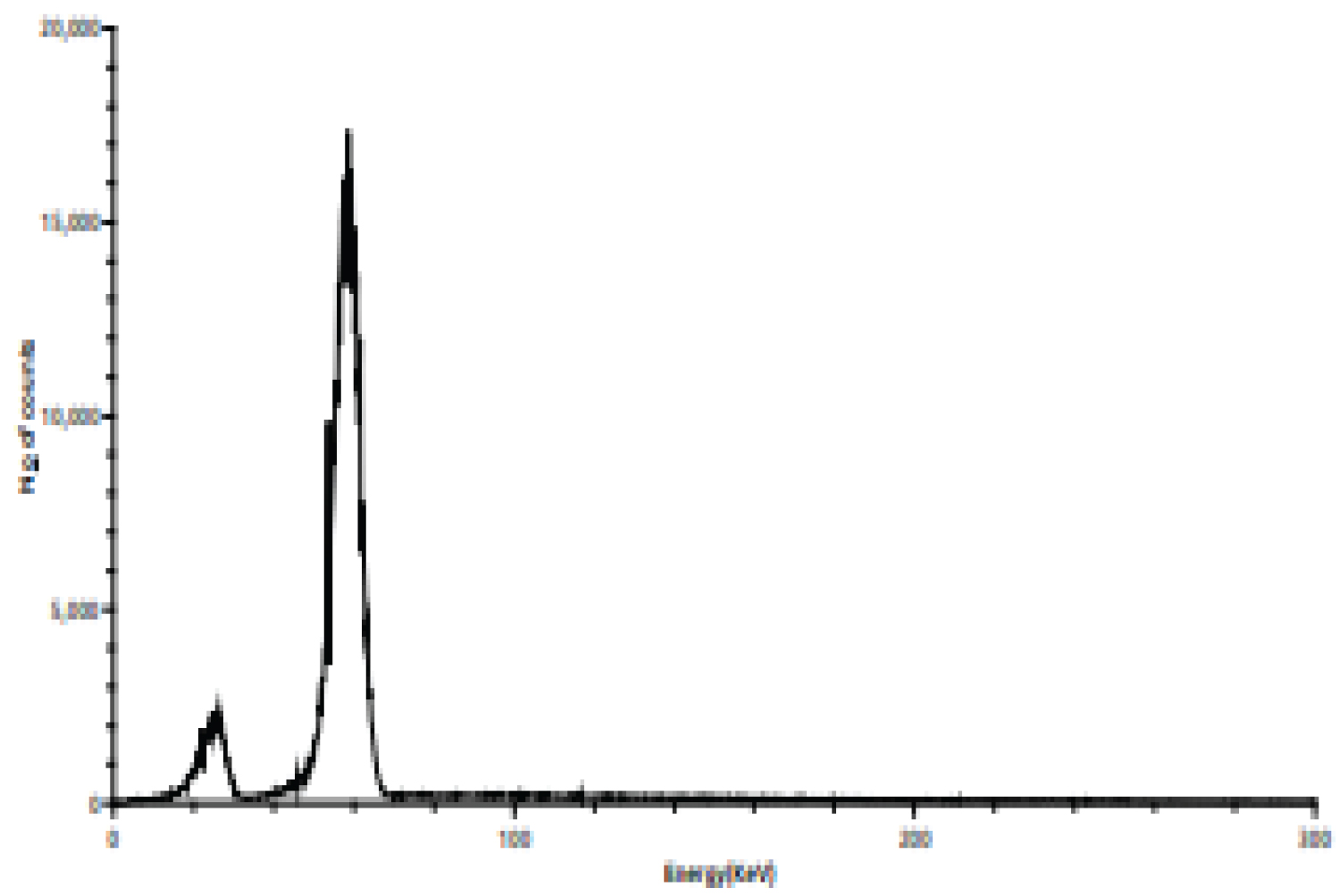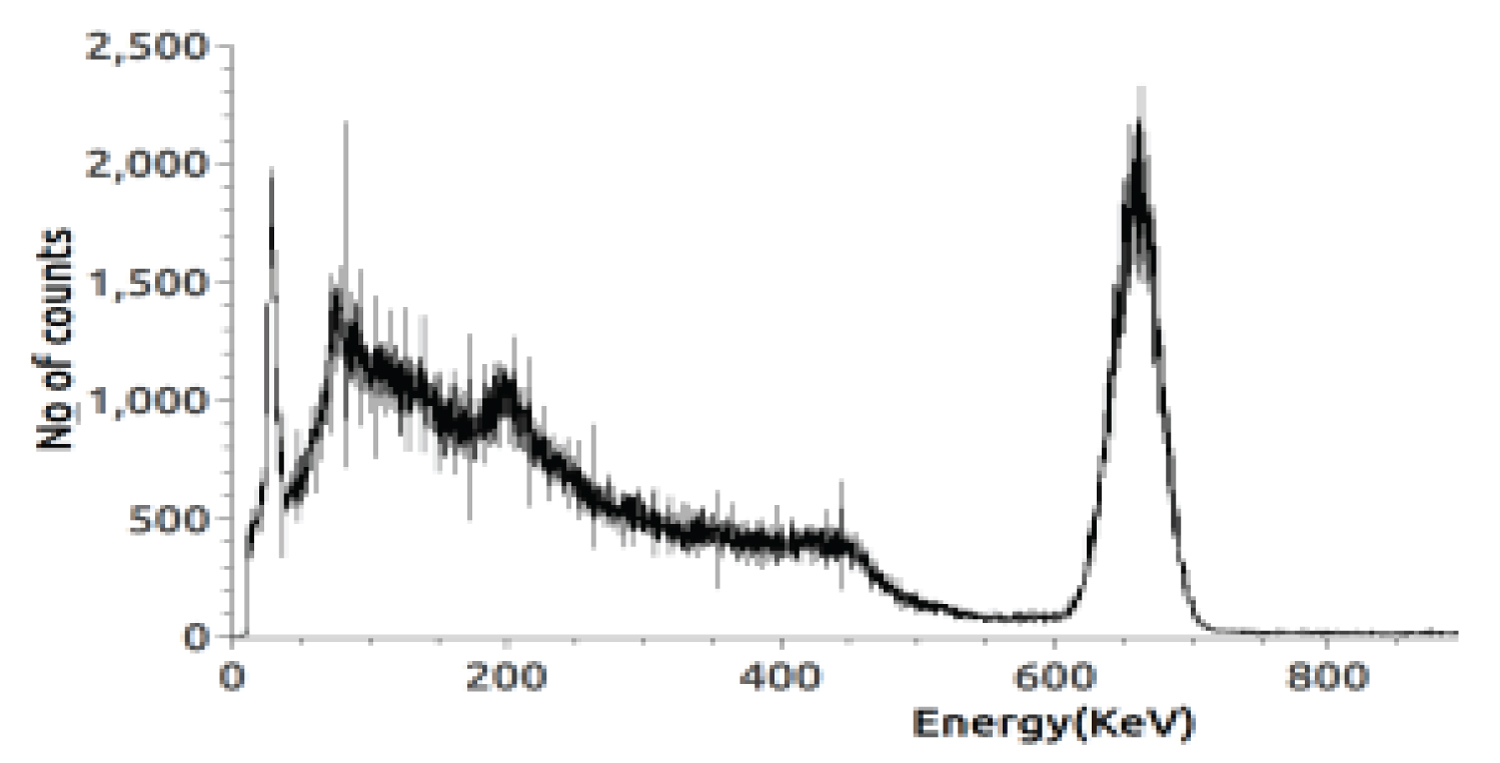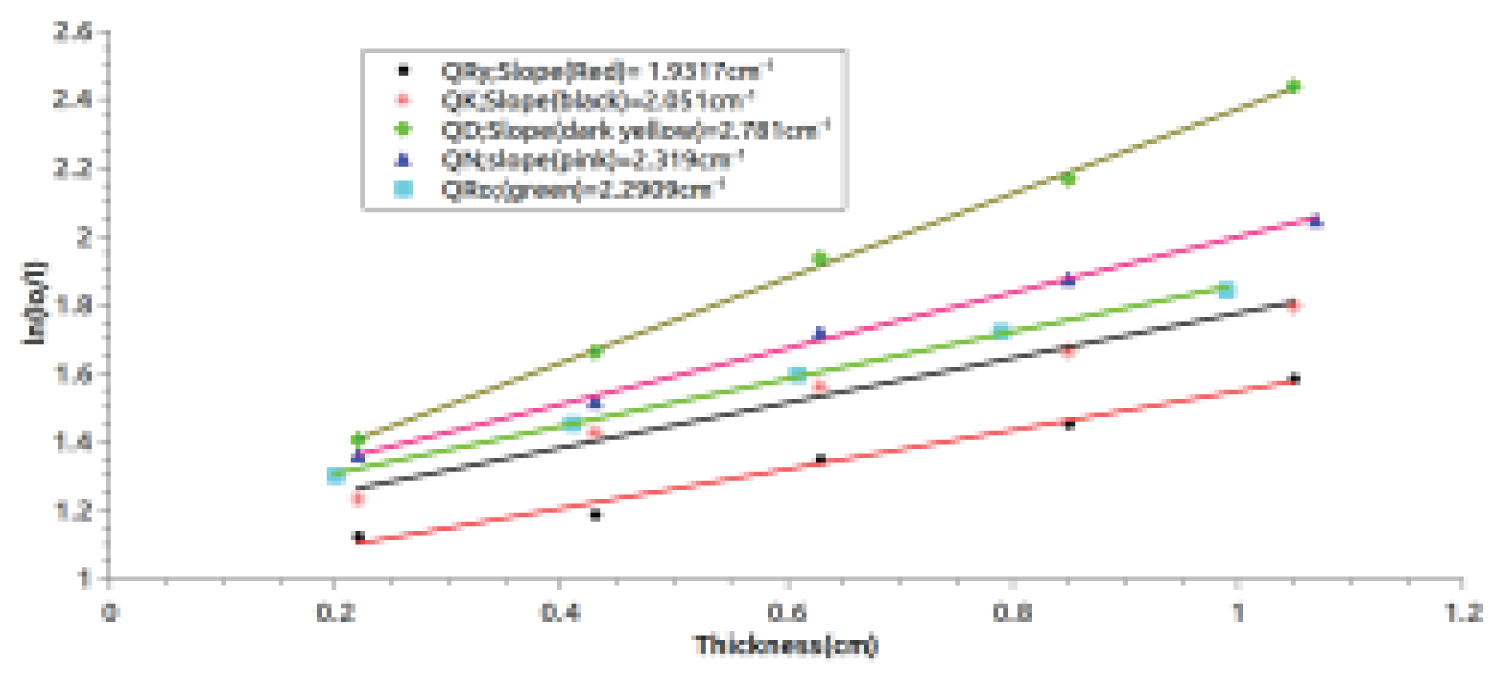Investigation of Gamma Attenuation Property of Different Brands of Quartz Samples Used for Wall Cladding in Ethiopia as a Function of Two Gamma Energies 59.6kev and 662kev
Abstract
The gamma-ray shielding ability of different brands of quartz used for cladding the exterior walls of residential and non-residential buildings has been investigated at 59.6 KeV, and 662 KeV gamma-energies. To this end, linear attenuation coefficient (µ), Half-value layer (HVL), and Tenth-value layer (TVL), and of the five Quartz brands were obtained. Based on those parameters, QD quartz brand is the highest attenuating brand of the other (2.781 cm -1 , and 0.3657 cm -1 ), the QD brands offer these thickness to reduce the intensity by half, HVL (0.249 cm, and 1.896 cm), and TVL (0.8279 cm, and 6.289 cm) at the two gamma energies 0.596 MeV, and 0.662 MeV respectively.
Keywords
Gamma-ray, Attenuation coefficients, Half value layer, Tenth value layer
Introduction
Early ignorance of the hazards of radiation resulted in numerous unexpected injuries to patients, physicians, and scientists, and as a result, some researchers took steps to publicize the hazards and set limits on exposure to radiation. A great deal of research, particularly animal studies, on the biological effects of radiation was carried out during and immediately after World War II. In 1949 the United States, Canada, and Great Britain held a conference at Chalk River, Ontario, on permissible doses of radiation. A number of new concepts concerning the measurement of dose had been developed through animal studies [1-4]. These included absorbed dose (measured in rad), dose-equivalent (measured in rem), relative biological effectiveness (RBE), which relates the rad to the rem for different types of radiations, and the absorbed dose as a function of photon energy [5]. For many buildings such as schools, churches and mosques, constructed in Ethiopia, quartz is used as cladding material. High attenuation coefficient materials used in a building construction especially for critical buildings such like accelerators, power stations and also hospitals, are very important for radiation shielding [6]. For the choice of shielding materials against radiation the characteristics of the material to attenuate gamma of specific energy is an important quantity and this has to be known. In choosing a material that is most suitable as a directly adhered cladding material for exterior walls, the gamma-ray shielding ability must be taken into consideration. The magnitude of the gamma attenuation depends on the incident photon energy, the atomic number and the density (ρ) of the materials [7-9]. With the rapid increase in the use and applications of ionizing radiation in several fields; such as medicine, agriculture, scientific and industrial areas, providing adequate protection to the public is becoming an important concern. Recently, Ethiopia is in accelerating development in science and technologies, such gamma sources have begun to commonly use. It is thus, useful to account for the shielding performance of the cladding facades against ionizing radiation. Therefore, we want to investigate the gamma-shielding property of the quartz used as external wall cladding in Ethiopia. Because not all building materials are the same quality through over the world [10]. In this study, the linear attenuation coefficient for some Quartz samples are measured by using a gamma-ray spectrometer and gamma sources 241 Am and 137 Cs. Measurements are carried out in Jimma University, Physics Department. The use of this research is to develop a shielding of local and identify different brands of quartz samples used as best gamma attenuator.
Materials and Methods
Five different quartz brand products were purchased from Addis Ababa construction materials shop prioritizing Ethiopian origin. From the five different brands of quartz purchased; quartz capsules were coded as QD, QN, QRo, and QRy. The samples characterized by measuring thickness by using the micrometer gauge. The characteristics of each sample after labeling were saved in a computer and the information was used during data analysis. Quartz samples were arranged and placed between radioactive sources and detector. The distance between source and detector was 12 cm; the experiment was repeated three times to minimize uncertainty and taken the average intensity for that particular peak. The data was saved in a computer and the sources 241 Am (59.6 keV) and 137 Cs (662 keV) were used as a radioactive source. The measurements were performed using gamma-ray spectrometer system containing sodium iodide with thallium activated crystal (NaI (Tl)) detector, multichannel analyzer (MCA), measure, and origin computerized software program, and high voltage power supply, and the experimental setup as shown in Figure 1. The method of the experimental procedure is known as the narrow beam gamma technique which is used to examine the ability of the materials against gamma radiation and used to determine attenuation coefficient of materials [11].
The Measurement of Linear Attenuation Coefficients
Attenuation of gamma radiation is an important component of radiation safety programs aiming to reduce personnel exposure to ionizing radiation. This process can be described by the linear attenuation coefficient, µ which can be expressed by the probability that a photon will interact with matter per unit length.
The radiation shielding for any material can be determined in terms of the linear attenuation coefficients µ (cm -1 ) [12]. The linear attenuation coefficients µ are measured by the following equation:
(1)
Where µ (cm -1 ) is the linear attenuation coefficient, Io is the gamma ray intensity at zero absorber thickness, I is the gamma-ray intensity transmitted through an absorber of thickness x (cm). where, is the attenuation coefficient (expressed in cm -1 ). The ratio (I/Io) in Eq.1 is called the gamma ray transmission and the above equation is known as the beer-lamberts law. Measurements with different sources and absorbers show that the attenuation coefficient (µ) depends on the gamma-ray energy and the atomic number (Z), thickness of absorber and density (ρ) of the absorber. The attenuation coefficient in Equation is called the 6linear attenuation coefficient. The relation in Eq. 1 is a straight line between in (I/10) and thickness x and the slope of this straight line gives µ.
Results and Discussion
The intensity of the two gamma energies was recorded without (I
o
) and with ceramics (I). During the experiment, gamma spectrums were saved and the intensity of each peak was determined using measure computerized software. The spectra obtained during the experiment with different brands of quartz were shown in Figure 2 and Figure 3.
7. Experimental Linear Attenuation Coefficient of Quartz Brands
The linear attenuation coefficient of ceramic brands per each energy was obtained using the slope of in (I/10) versus thickness (x) curves. The curves were drawn by data plotting software called origin software.
The graphs for in (I o /I) versus thickness (x) curves per each energy of their slopes were shown in Figure 4. The experimentally determined gamma attenuation coefficient of quartz samples depends on gamma energy and quartz brands shown in the Table 1. When the gamma energy increases the gamma attenuation coefficient of the quartz brands decreases. From Table 1, QD quartz brand, as an example has a linear attenuation coefficient of 2.7811 cm −1 for Eγ = 0.0596 MeV, 0.3656 cm -1 for Eγ = 0.662 MeV. When the thickness of the brand increases the gamma attenuation coefficients also increases. From the results, we see that the intensity of gamma energy decreases exponentially as Eq. 1. The higher the thickness the attenuation ability high (the chance of the intensity pass through absorber is low for large thickness).
All the quartz brands show the different values of the gamma attenuation coefficient for given gamma energy [13]. From Table 1 we see that the values of linear attenuation coefficients are different for given gamma energy. From the experimental result, the increasing order of gamma attenuator of different quartz brands were QRy, QK, QRo, QN, and QD quartz brands. The attenuation coefficient depends on the nature of materials contained in the composite sample investigated in different literature [14]. The best brand is the brand that attenuates more gamma intensity for a given thickness and gamma energy. This phenomenon can be explained based up on the HVL. The brand which gives a small thickness for HVL is a better attenuator than that of greater thickness. The HVL for all brands considered in this work were shown in Table 1.
Conclusion
From the result, we concluded that the linear attenuation coefficient depends on the nature of absorbing materials and the energy of incident photons. From the experimental results, QD quartz brand is the most gamma attenuator of all the four other brands and QRy quartz brand is the least gamma attenuator from the other four quartz brands at 59.6 keV, and 662 keV gamma energies.
References
- Frame PW (2005) A history of radiation detection instrumentation. Health Phys 88: 613-637.
- Wang J, Li G, Meng D (2014) Evaluation of the performance of peridotite aggregates for radiation shielding concrete. Annals of Nuclear Energy 71: 436-439.
- Profio AE (1979) Radiation shielding and dosimetry.
- Samarin A (2013) Use of concrete as a biological shield from ionizing radiation. Energy and Environmental Engineering 1: 90-97.
- Udagani C (2013) Gamma ray attenuation study with varying moisture content of clay brick. International Journal of Engineering Science Invention 2: 35-38.
- Okello DE (2015) Gamma ray spectrometric analysis of the naturally occurring radionuclides in soils collected along the shores of Lake Victoria. Migori County, Kenya.
- Rajasekhar E, Narasimham KL, Jeevan KR, et al. (2015) Comparison of gamma ray attenuation coefficients of wood materials with theoretical values. J Global Bio Sci 4: 1836-1841.
- Sayyed MI, Elmahroug Y, Elbashir BO, et al. (2017) Gamma-ray shielding properties of zinc oxide soda lime silica glasses. Journal of Materials Science: Materials in Electronics 28: 4064-4074.
- Dickson ED (2013) Experimental shielding evaluation of the radiation protection provided by residential structures.
- Mittal VK, Verma RC, Gupta S (2018) Introduction to nuclear and particle physics. PHI Learning Pvt. Ltd.
- Singh R, Singh S, Singh G, et al. (2017) Gamma radiation shielding properties of steel and iron slags. New Journal of Glass and Ceramics 7: 1-3.
- Biswas R, Sahadath H, Mollah AS, et al. (2016) Calculation of gamma-ray attenuation parameters for locally developed shielding material: Polyboron. Journal of Radiation Research and Applied Sciences 9: 26-34.
- IAEA (International Atomic Energy Agency (1992) Effects of ionizing radiation on plants and animals at levels implied by current radiation protection standards. Technical Report No 332 Vienna.
- Oto B, Gur A (2013) Gamma-ray shielding of concretes including magnetite in different rate. International Journal of Physical Sciences 8: 310-314.
Corresponding Author
Gemechu Feyisa Yadeta, Department of Physics, College of Natural Science, Mattu University, Mattu, Ethiopia.
Copyright
© 2024 Yadeta GF. This is an open-access article distributed under the terms of the Creative Commons Attribution License, which permits unrestricted use, distribution, and reproduction in any medium, provided the original author and source are credited.

